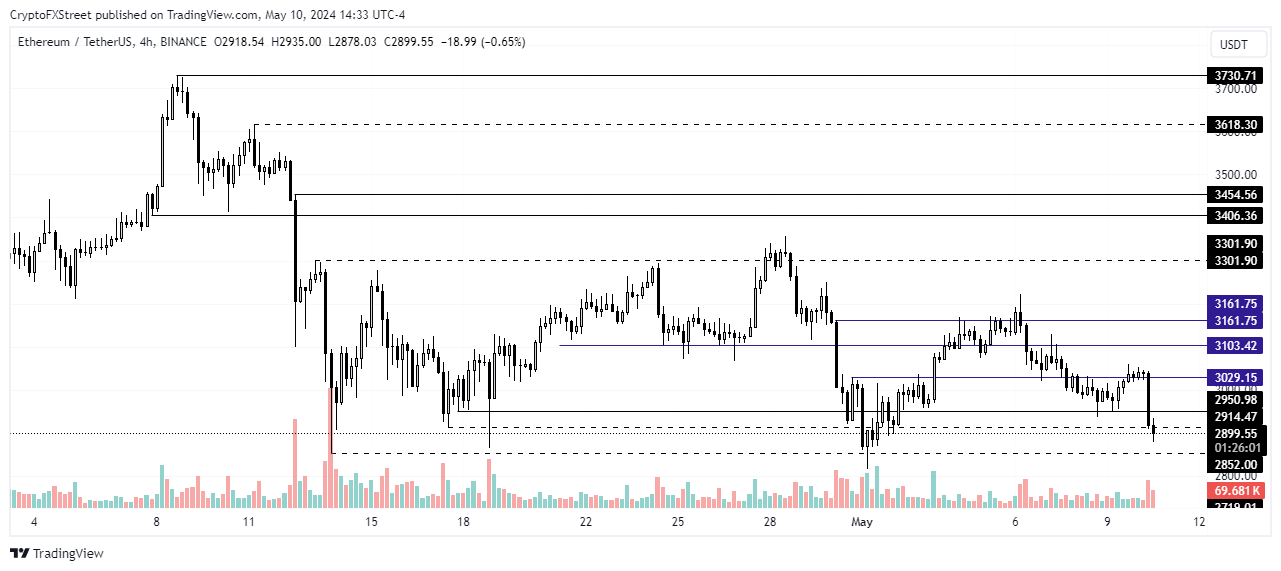- Ethereum has seen nearly a 5x growth in monthly active addresses since 2022, reaching 7.6 million.
- Insights from Glassnode show that Ethereum has underperformed Bitcoin in terms of price performance since the recent bull cycle began.
- Ethereum will likely continue trading in key range without a bearish macro event.
Ethereum (ETH) saw a sharp price decline on Friday as it has nearly 5x user growth since 2022. Glassnode also revealed key data insights that showed Ethereum has underperformed Bitcoin (BTC) in recent times.
Also read: Ethereum needs a bullish trigger, Joseph Lubin blasts the SEC
Daily digest market movers: Active user growth, declining gas fees, underperforming Bitcoin
Ethereum Layer 2s are about to set a new all-time high in terms of active addresses, with more than 5.2 million monthly active users as of May 5, according to data posted by Leon Waidmann. Combined with monthly active users from the ETH Mainchain, the Ethereum ecosystem would have recorded nearly 7.6 million monthly active users — almost 5x active users in 2022.
The surge in user growth coincides with declining gas fees for Ethereum Layer 2s, which have been reduced more than tenfold since the Dencun upgrade in March, according to data from IntoTheBlock.
Meanwhile, Glassnode data shows that Ethereum has underperformed in the last two years when compared to Bitcoin. This is seen in a low ETH/BTC ratio and ETH drawdown in this cycle (-44%), doubling Bitcoin’s (-21%). The Net Unrealized Profit/Loss (NUPL) of Bitcoin “crossed 0.5 and entered the euphoria phase three months before the equivalent metric for Ethereum,” noted Glassnode.
Typically, an NUPL greater than 0.5 means unrealized profit from investors is greater than half of an asset’s market capitalization.
Another key insight from Glassnode data shows that Ethereum is trading close to the purchasing cost of short-term holders (investors who bought the asset within the last 155 days). The short-term holder’s cost basis often serves as a resistance during a bearish trend or support during a bullish trend. With the price of Ethereum close to the average STH cost level of $3,010, Glassnode has suggested that recent buyers may “panic should the market experience downside volatility.” Recent reported whale purchases around this price level align with Glassnode’s STH cost basis.
One interesting part of Ethereum’s on-chain activity Glassnode highlighted is that long-term holders within the past one to two years are still holding onto their positions in hopes of “better profit-taking opportunities.”
ETH technical analysis: ETH may continue trading in key range despite recent decline
Ethereum saw a price inefficiency on Friday, extending from $3,045 to $2,905. This was accompanied by a sharp liquidation of long positions, reaching $27 million within four hours.
Also read: Ethereum resume sideways move as Grayscale files to withdraw Ethereum futures ETF application with the SEC

ETH/USDT 4-hour chart
The move isn’t a surprise as ETH has leaned toward the downside in the past few days despite uncertainty among traders. However, key predictions remain unchanged as ETH would likely remain trading within the $2,852 to $3,000 range.
The recent decline could present a buying opportunity for whales who have continued purchasing ETH around the $3,000 mark. Without any bearish macro event in sight, ETH would likely hold the range until the SEC decides on Van Ecks’ spot ETH ETF application on May 23.
Bitcoin, altcoins, stablecoins FAQs
Bitcoin is the largest cryptocurrency by market capitalization, a virtual currency designed to serve as money. This form of payment cannot be controlled by any one person, group, or entity, which eliminates the need for third-party participation during financial transactions.
Altcoins are any cryptocurrency apart from Bitcoin, but some also regard Ethereum as a non-altcoin because it is from these two cryptocurrencies that forking happens. If this is true, then Litecoin is the first altcoin, forked from the Bitcoin protocol and, therefore, an “improved” version of it.
Stablecoins are cryptocurrencies designed to have a stable price, with their value backed by a reserve of the asset it represents. To achieve this, the value of any one stablecoin is pegged to a commodity or financial instrument, such as the US Dollar (USD), with its supply regulated by an algorithm or demand. The main goal of stablecoins is to provide an on/off-ramp for investors willing to trade and invest in cryptocurrencies. Stablecoins also allow investors to store value since cryptocurrencies, in general, are subject to volatility.
Bitcoin dominance is the ratio of Bitcoin’s market capitalization to the total market capitalization of all cryptocurrencies combined. It provides a clear picture of Bitcoin’s interest among investors. A high BTC dominance typically happens before and during a bull run, in which investors resort to investing in relatively stable and high market capitalization cryptocurrency like Bitcoin. A drop in BTC dominance usually means that investors are moving their capital and/or profits to altcoins in a quest for higher returns, which usually triggers an explosion of altcoin rallies.

























